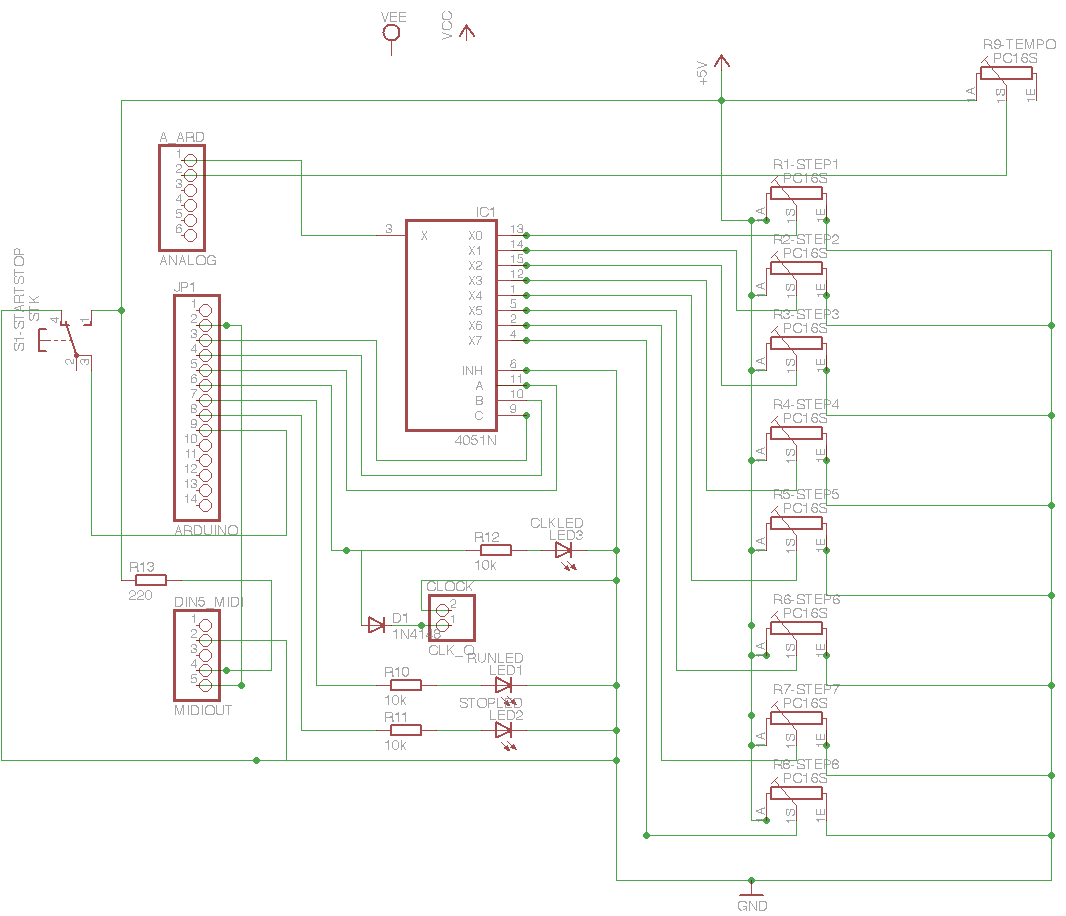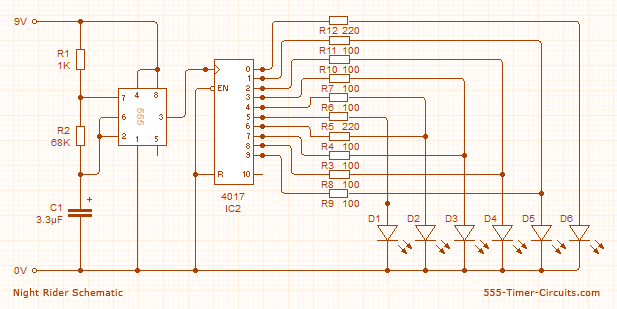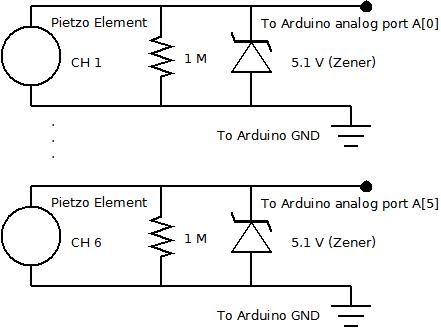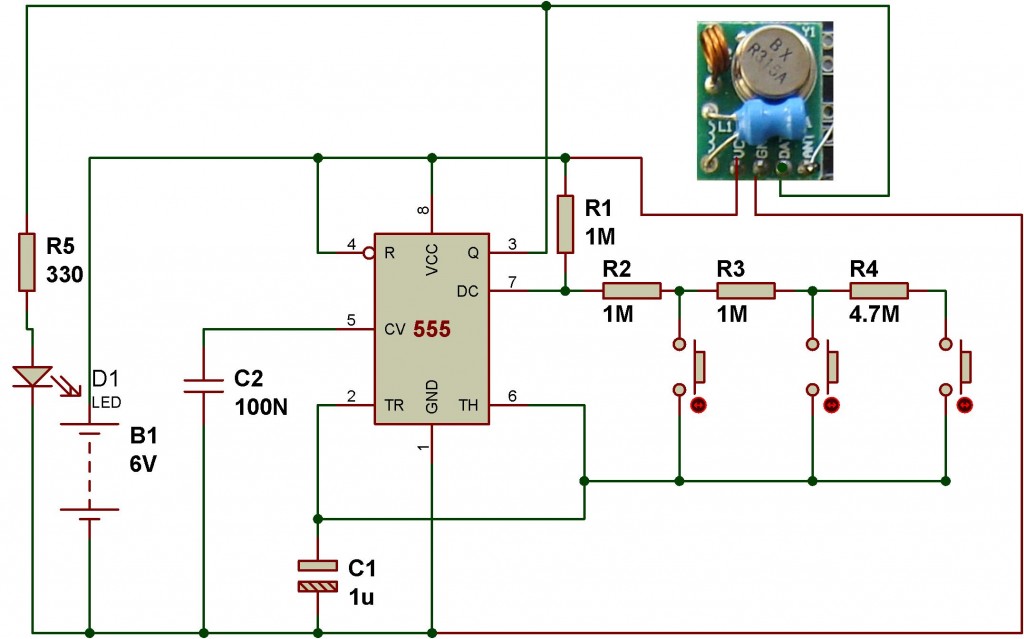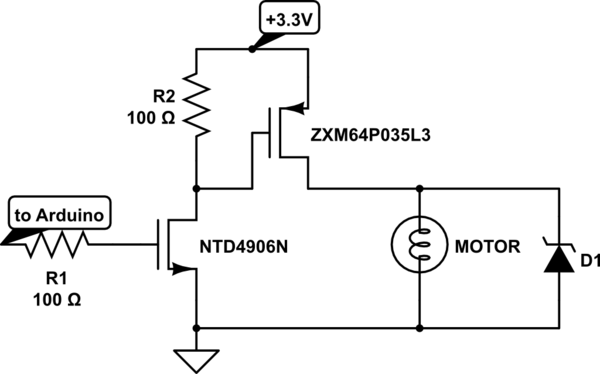
arduino knight rider

Construct a Knight Rider LED display on a breadboard using an Arduino controller. This is a straightforward circuit designed for beginners in electronics, utilizing an Arduino Uno.
The Knight Rider LED display emulates the iconic light sequence from the television series, where a series of LEDs light up in a moving pattern. This project is ideal for beginners as it introduces fundamental concepts of electronics, programming, and circuit assembly.
The circuit typically consists of an Arduino Uno microcontroller, several LEDs, resistors, and a breadboard for assembly. The LEDs are arranged in a linear fashion, simulating the effect of a moving light. Each LED is connected to a digital output pin on the Arduino through a current-limiting resistor, which is essential to prevent excessive current from damaging the LEDs.
To implement the project, the following components are required:
- Arduino Uno board
- Breadboard
- 10 LEDs (preferably in a single color for uniformity)
- 10 resistors (220 ohms or 330 ohms, depending on the LED specifications)
- Jumper wires for connections
- A USB cable for programming the Arduino
The basic circuit design involves connecting the anode (longer leg) of each LED to a separate digital pin on the Arduino, while the cathode (shorter leg) is connected to the ground through a resistor. The Arduino is programmed to turn on and off each LED in sequence, creating the visual effect of a moving light.
The programming aspect involves writing a simple sketch in the Arduino IDE that defines the sequence in which the LEDs will light up. The delay function can be used to control the speed of the light movement. This project not only enhances understanding of basic circuit connections but also provides practical experience in coding and debugging Arduino programs.
In summary, the Knight Rider LED display project is an excellent starting point for those new to electronics, offering hands-on experience with both hardware and software components in a fun and engaging manner.Build a Knight Rider LED display on breadboard controller by an Arduino. An easy circuit for beginners in electronics using an Arduino Uno.. 🔗 External reference
The Knight Rider LED display emulates the iconic light sequence from the television series, where a series of LEDs light up in a moving pattern. This project is ideal for beginners as it introduces fundamental concepts of electronics, programming, and circuit assembly.
The circuit typically consists of an Arduino Uno microcontroller, several LEDs, resistors, and a breadboard for assembly. The LEDs are arranged in a linear fashion, simulating the effect of a moving light. Each LED is connected to a digital output pin on the Arduino through a current-limiting resistor, which is essential to prevent excessive current from damaging the LEDs.
To implement the project, the following components are required:
- Arduino Uno board
- Breadboard
- 10 LEDs (preferably in a single color for uniformity)
- 10 resistors (220 ohms or 330 ohms, depending on the LED specifications)
- Jumper wires for connections
- A USB cable for programming the Arduino
The basic circuit design involves connecting the anode (longer leg) of each LED to a separate digital pin on the Arduino, while the cathode (shorter leg) is connected to the ground through a resistor. The Arduino is programmed to turn on and off each LED in sequence, creating the visual effect of a moving light.
The programming aspect involves writing a simple sketch in the Arduino IDE that defines the sequence in which the LEDs will light up. The delay function can be used to control the speed of the light movement. This project not only enhances understanding of basic circuit connections but also provides practical experience in coding and debugging Arduino programs.
In summary, the Knight Rider LED display project is an excellent starting point for those new to electronics, offering hands-on experience with both hardware and software components in a fun and engaging manner.Build a Knight Rider LED display on breadboard controller by an Arduino. An easy circuit for beginners in electronics using an Arduino Uno.. 🔗 External reference
